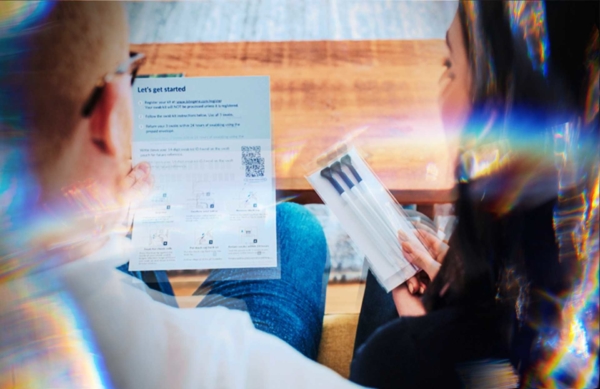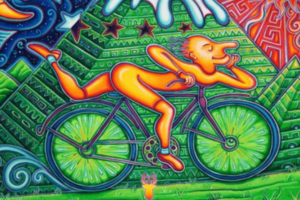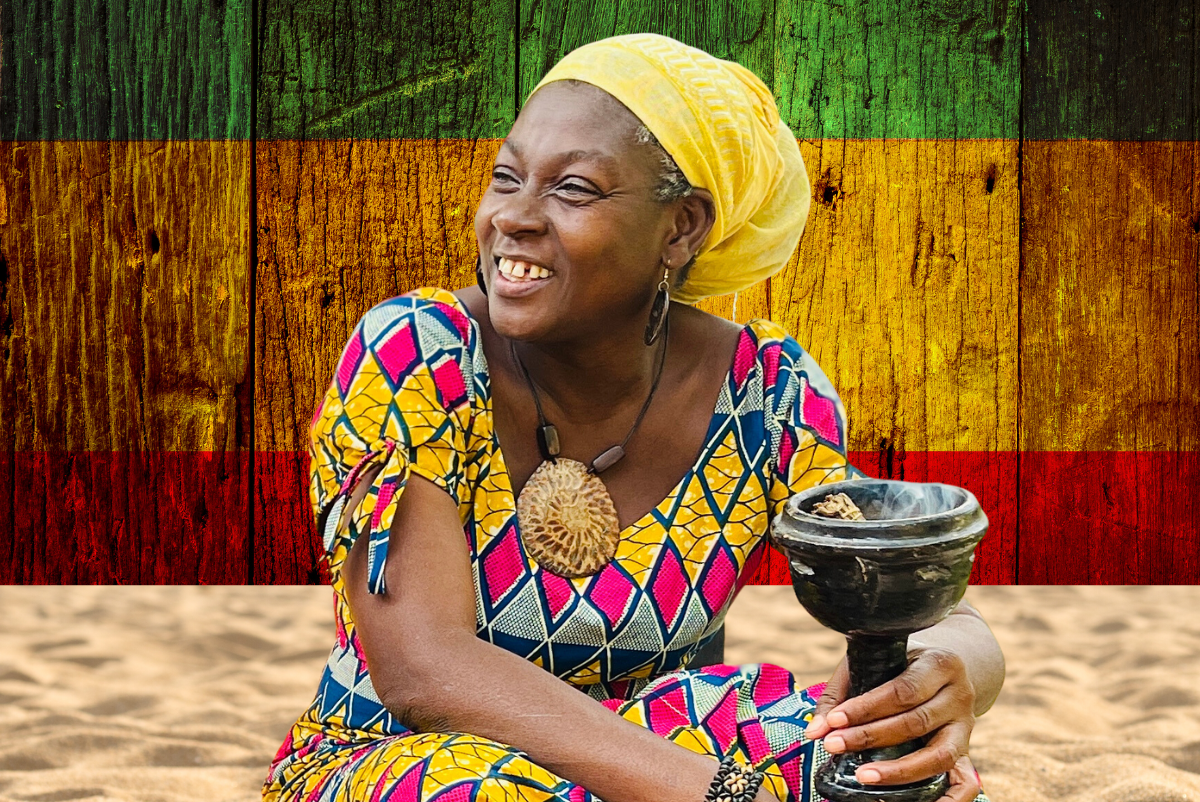
We’re well into booking season for those winter getaways. Fancy something a bit more adventurous and profound? How about a Rastafari psychedelic retreat in beautiful Jamaica? Sound intriguing? If you’re reading this and considering an all-inclusive elevated experience while looking up flight sales from the comfort of your North American abode, you might just be a psychedelic tourist. There’s no shade in the name, or the association, in fact you’re likely a psychedelic tourist because you’re exploring deeper personal potential, open to healing, and seeking more connection or purpose. These are all good things!
So, psychedelic tourism: how do we unpack the term that’s now become part of our mainstream vernacular?
To encapsulate the essence in a nutshell; most would describe it as a chance for individuals to delve into uncharted realms of consciousness, tap into age-old wisdom, and engage with a variety of cultural settings and rituals. Speaking of cultural settings, we’re about to dive into an interview and learn about a Rastafari psychedelic retreat that offers all of the above, but first, let’s get our bearings.
Psychedelic tourism really got its start back in the 1950s when Gordon Wasson’s article in Life Magazine made its way to every newsstand and cigarette shop across America. The article featured a story about his psilocybin ceremony with the Mazatec healer María Sabina in Huautla de Jimenez, Mexico. This event propelled Sabina and the mystic voyage into the spotlight, attracting a wave of Western seekers to Huautla, including celebrities like John Lennon, Bob Dylan, and Mick Jagger.
However, it’s easy to guess why psychedelic spiritual tourism has experienced an even more significant surge in the last four years. Psychedelics have taken over the airwaves and mainstream media, and state by state, we’re seeing the decriminalization of psychedelic personal use, the legalization of medical use, and a mushroom explosion of biotech companies jockeying for their chance at being the poster child of standardized doses via prescriptions for a variety of indications.
I’d like to add another layer that I believe contributes to the uptick in spiritual and psychedelic retreats, which is a possible longing for ritual. Since the separation of church and state, the rise in popularity of Eastern philosophical armchair experts, and our scientific bent on imperialistic proof and pragmatism, America has become chiefly and vaguely agnostic, abiding by the rules of a public sphere that is secular at its core. Actual religious practice and ritual is mostly confined to the private sphere and no longer all that visible.
The rub is that neuroscience backs the benefits of spiritual rituals and many aspects of religious communities. However I won’t go down that rabbit hole today; I’ll leave that for another time.
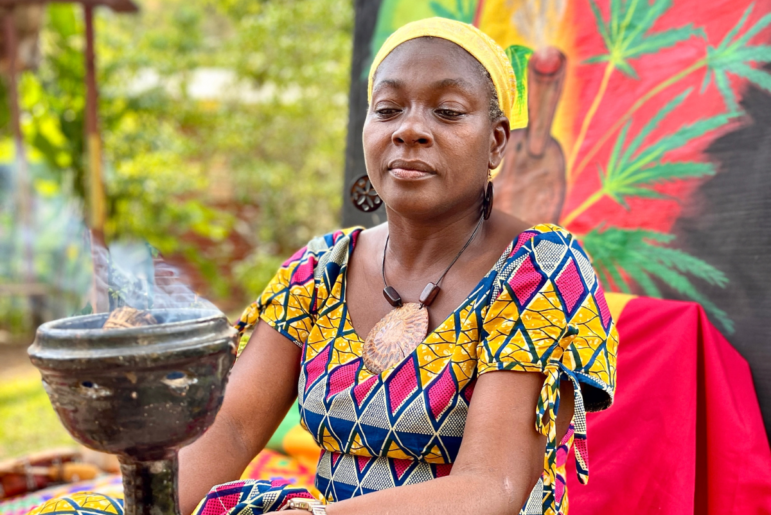
With this cultural cocktail in mind, I bring us now to an interview I recently had with a self proclaimed shaman who runs a Rastafari psychedelic retreat out of Jamaica, but first, a word of caution. As many are aware, the psychedelic retreat market is fraught with just as many svengalis as there are authentic shamans, and there are horror stories out there about folks who’ve been heavily manipulated and robbed blind by bad actors. This is why it’s imperative to do your homework when researching retreats and psychedelic services.
As a rule of thumb, here is just a quick list to check off when scanning websites, and looking at facilitators:
Is it legal?
Psychedelics are legally ambiguous in many places. Certain psychedelics enjoy full legalization in a handful of countries, including the Netherlands, Jamaica, the Bahamas, and Brazil. In other regions, while they may not be officially legal, they are decriminalized or operate in a regulatory gray area. Violating international laws in this context can lead to challenging legal circumstances if one is apprehended, so proceed with caution.
Do they provide co-therapy (a mix of local and western medically trained staff?)
Psychedelic retreats take place in countries where the conventional licensing and FDA authorization boundaries do not hold any sway. This creates an environment where spiritual guides and shamans can operate. Typically, these retreats are led by one or a few individuals who may possess knowledge and experience but are not necessarily required to meet standardized educational qualifications for their practice. Again, make informed choices.
What compound and what dosage is used?
Ensure you are well informed about the substance you are ingesting, its dosage, and the anticipated duration of the experience. For psilocybin beginners, check this guide:
For ayahuasca beginners, I recommend this article.
What is the set and setting?
“Set” and “setting” pertain to the internal and external elements that shape your psychedelic encounter. “Set” encapsulates your inner landscape, encompassing aspects like your emotional state, personality, beliefs, and perceptions. “Setting” contains everything external, including the people present, their actions, the music, scents, weather conditions, and even the less apparent cultural influences.
A Word About Shamanism
When sleuthing the validity of shamans and psychedelic spiritual workers, I must submit some thoughts around framing the term. It is not feasible to establish a straightforward definition of shamans and shamanism through diagnostic classifications or by aligning them with other mystical traditions. Instead, it is essential to approach them as distinct and singular phenomena. When speculating the value or authenticity of a Rastafari psychedelic retreat, or any other psychedelic retreat, ultimately, we must trust our guts, see what others in their communities say about them, and look at their relationship with financial exchanges. After years of studying various religious practices, and obtaining a degree on the topic, I find myself constantly reminded of the bricolage effect that most modern shamans possess.
The following interview dives a little deeper into understanding these complexities, their unique genesis stories, and their methodologies.
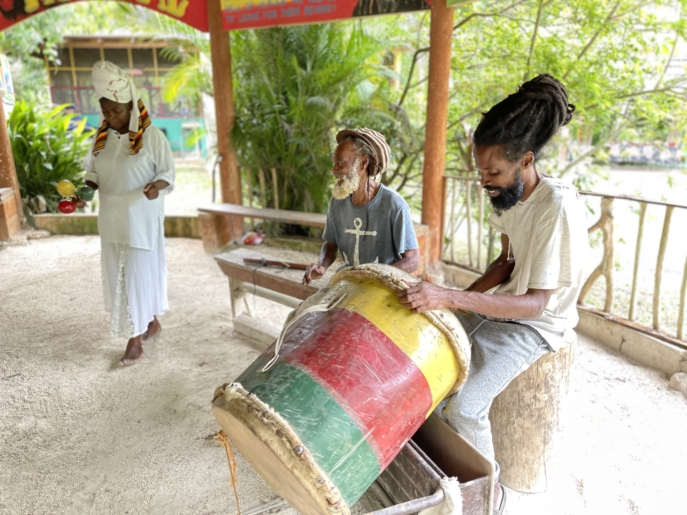
The Interview
Early this month, I was introduced to Queen Izeteh Berhan, also known as Queen I, who runs a Rastafari psychedelic retreat in Jamaica, by her outreach team. According to her BIO, “Queen I is a Rastafari artisan, teacher, and mother to four children. She considers herself a One Love Therapist™, intuitively working with the essential elements of fire, earth, water, and wind. She has been trained as a Reiki Energy Healing Master and has been practicing for 22 years — she’s been a plant medicine facilitator since 2016, and is a lifelong student of traditional Rastafari Ital cooking and healing techniques.
Queen I has embraced the preservation of indigenous healing techniques within the Rastafari and wider Jamaican society as a personal mission. She knows the healing properties of almost every plant in the garden and how to prepare and administer them. At her workshop in the Village, Queen handcrafts a wide variety of skin-care products from indigenous Jamaican plants and herbs and also offers her adaptation of traditional herbal bush-baths. Queen I attended the Edna Manley College of the Visual and Performing Arts and was an English teacher at the prestigious Jamaica College, a traditional high school. She was one of the earliest employees at the groundbreaking IRIE FM radio station, one of the first station to play reggae music around the clock. Her work there as a record librarian gave Queen I deep exposure to a wide range of reggae music and helped guide her to Rastafari livity (way of life). Among other achievements at IRIE FM, Queen I was an original pioneer of using Jamaican patois in advertising announcements — becoming a recognized and beloved voice in every part of the island.”
PS: At what age did Queen I realize her calling as a Shaman? What specific event in her life solidified this for her?
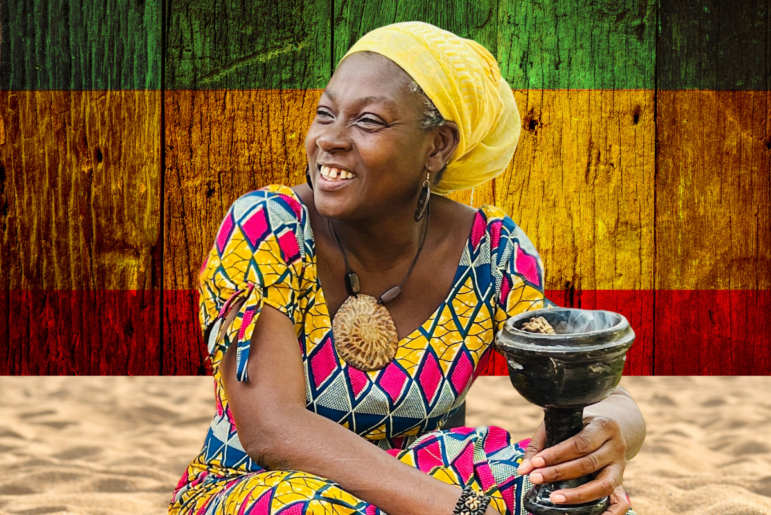
Queen I:According to my understanding of Shaman, there is a particular lineage of indigenous people who have inherited or who have been trained in preparing and administering a certain set of rituals and practices in regards to plant medicine, spirituality and healing, who have ancestral connections to the land.
I live in Rastafari. On connecting to the Rastafari livity (way of life) about 30 years ago, I found myself. What the Rastafari livity has done and is still doing is incorporating spirituality of African people who are on a path of reclamation and self determination.
In connecting to self, the remnant of African people’s tradition, rituals and practices are intertwined into the culture of a colonized society — a people lost, incorporating bits and pieces from genetic memory, dreams, and interactions with others directly from the continent of Africa and other eastern continents. Rastafari is a livity that honours the relationship with Mother Earth, its plants, its animals, its people, the minerals, the elements, and its fullness. It expresses itself through the interaction with ganja as a sacrament and philosophy source. Through food as medicine, through language as a guide for vibrations, through originality, creativity, naturalness and universal oneness.
PS: Given Queen I’s dedication to preserving indigenous healing practices within Rastafari and Jamaican communities, how does she approach sharing these sacred techniques with individuals from different cultural backgrounds?
Queen I: The Rastafari Indigenous Village is specially designed for sharing, giving credence to the ancients’ adage of “Each One, Teach One.” Due to the sad fact that this livity is faced with extinction, we see the need to preserve, and protect it with the vehicle of promotion. The village offers a day time cultural immersion called Rastafari Riddims, and a 5 day long retreat experience called Life Is A Ceremony. I assist in co-curating, facilitating these experiences and offering to both the local and international community. This provides the opportunity for integrating the teachings and lessons of the plant as a way of life, of livity, incorporating them through our Ital food, sacred plants, African spirituality, traditional music and dance, artistry and creative language.
PS: We have so much to gain from our indigenous elders and their communities. What are Queen I’s views on how reciprocity should be practiced towards indigenous elders and their communities by those who are invited to participate in ceremonies?
Queen I: he very first thing is to respect our ways and norms and the established spiritual traditions of our elders. We also see the openness to share resources, time and contributions, monetary or other equivalents as balancing the spirit of reciprocity.
PS: Cannabis is often associated with Rastafarian religious practices, is this the primary plant that Queen I utilizes in her role as a Rastafari psychedelic retreat shaman? Could you elaborate on the theological and ritualistic aspects of how this plant is incorporated into her individual healing sessions or within the context of her retreat, Life Is A Ceremony?
Queen I:Even though I share ganja in ceremony, it is the daily lessons that the plant teaches that connects with I and I becoming, promoting, integrating instead of merely integration. Rastafari Indigenous Village, by itself is a healing environment that goes beyond sessions. It was originally designed as a “Healing for Healers.” Therefore, natural life of the village space is structured to provide the artisans with healing tools such as one love channelling, bush baths, cannabis sharing, stories by the fire, drum-making, soap- making, drumming and dancing, cooking Ital food and farming.
PS:Considering the monotheistic and historic foundations of Rastafarianism, how does Queen I reconcile the tenets of this faith with healing modalities from other spiritual traditions, such as Japanese Reiki?
Queen I:The foundation of Rastafari is based on knowing self and accepting self. Therefore it is not a religion. It is a relationship with all aspects of earth and earth healing. It embraces the intrinsic connection of plants, people and animal life to the universal source and the natural roles they were all designed to play. There is no separation or hierarchy in relation to life. Harmony is the key goal here. Any aspect of life that is naturally doing this is incorporated in any Rastafari individual that it resonates with.
The example of Emperor Haile Selassie I and Empress Wozero Menen has shown the possibility of harmony and in the emperor’s words, “you must become bigger than you have ever been, more courageous, greater in spirit, larger in outlook. You must become members of a new race, overcoming petty prejudices, and holding our allegiance not to nations but to our fellow human beings of this earth.” At Rastafari Indigenous Village, on any given day, humanities expressions through heart meditation, yang herbal foot soaks, yoga, reiki, paida lajin, breath work, acupressure, massage, i-ching, numerology and card reading can all be a feature of natural village life. We are tolerant of any earthling who practices and expresses in this dispensation, including ancient healing techniques of humanity called by any given name.
PS: As a shaman and facilitator of plant medicines, which other plants does Queen I most frequently use in her practice?
Queen I: Plant interaction is a way of life and the plants are part of the ecosystem. There are plants that carry a certain frequency of vibration and are deliberately selected to carry about specific purposes in our bush bath practice; lime is a plant that is traditionally used to cut and clear spells and bring forward clarity to a personal situation. Rosemary is purposely used for its rejuvenating effect on the memory. Pepper elder is a protection from traps and snares.
We also interact with the plant in daily life, in the making and usage of soaps. Noni is a plant that carries collagen naturally and castor bean makes castor oil by harvesting and boiling it, helping strengthen and protect the hair and skin. Turmeric root is mainly used for inflammation and assists with acne. In our sacred practices, we use sage, frankincense, myrrh, palo santo, lemongrass and copal to name a few. At Life Is A Ceremony retreats we give reverence to all plants.
PS: Does Queen I believe that these plants possess either feminine or masculine spirits, akin to how Amazonian cultures view Rapé and Sacred Tobacco as embodying a grandfather spirit, and Ayahuasca as a grandmother spirit? If so, how do these beliefs integrate with her Rastafari psychedelic retreat and healing techniques? If not, what spiritual aspects does she ascribe to the plants?
Rastafari, like many indigenous cultures, see duality in life. There is the sun and the moon, fire and water, male and female, thunder and lightning, yin and yang. I and I respect those natural laws of nature. This extends also to the plant world. Ganja, a journeying plant, fulfills very clearly the principle of duality in nature. The male ganja plant bears pollen and the female bears flowers. Those laws of nature are recognised by us as well as the principles, rituals and practices established by our ancestors. I n I walk within their footsteps.
PS: Many consider music to be a form of spiritual expression and even a healing force. In her capacity as a DJ, what is Queen’s perspective on the role of music in contemporary society? Is music integrated into her spiritual practices? Additionally, does she incorporate music into her ceremonies, and if so, what genres or types of music does she typically use?
Queen I: Music has always been a unifying force that brings about harmony across all cultures. The upful vibrations of Rastafari have been streamlined into music. Music is the saviour, the teacher, the comforter, the healer and redeemer. I n I certainly give gratitude for music through the playing of instruments and chanting. It is one of the most powerful tools of One Love. The Nyabinghi Riddim is the rhythm of Rastafari. There are three main drums as well as maracas or shakers. The nyabinghi bass drum is the largest drum and is considered the HEARTBEAT as it goes with the human heart’s timing. It represents the humble grounding and foundation, in essence — Mother Earth. The fundeh is the other necessary accompanying drum that follows the akete drum, which is known as the talking drum of repetition. They are gracefully complimented by the shakers. In this reverent combination sacred sounds are created.
This is the origin of the world’s most popular music, reggae, that resonates with earth’s people on a global level. Crossing all barriers and creating ONE LOVE, or harmony. As a ONE LOVE CHANNELER, Queen I music is a very essential part of our healing practices that will create an ambiance of change. It is that sound of fire that corrects and transmutes evil into good. It purges the air and creates healing. It stays with the person in care long after the session has completed.
Queen I trod inna Babylon as a music librarian at Irie Fm 105.5 in Jamaica, and introduced I to the music of Rastafari and through listening and hearing the teachings and messages of the elders it inspired. I further journey into the livity of Rastafari. Queen I may use reggae music in private ceremonies and in my bush bath, however for the Life Is A Ceremony community experiences, it is the traditional live drumming of Rastafari Nyabinghi or Kumina that is my preferred choice of healing and expressions.
PS: Does Queen have Spotify or SoundCloud? Where can we listen to some of her legendary mixes!?
Queen I:At the moment, I have nothing on Spotify or any other platforms around the globe. You will have to come to Rasta Village to hear Queen I selections.
There you have it, folks; Queen I appears to be the quintessential healer to whom many would ascribe the term Shaman or Medicine Woman. I personally love her utilization of multiple spiritual modalities, while honoring her Rastafarian roots.
As for the Rastafari Psychedelic retreat itself, Life Is A Ceremony is legal! Their website states, “Rastafari Indigenous Village is recognized as a sacramental community by the Government of Jamaica, and all our offered activities and medicines are 100% legal”. When looking at the cost associated with this experience, Life Is A Ceremony seems to be one of the most affordable retreats I’ve seen in Jamaica, charging just $2000 a person, and it offers a genuinely unique experience replete with education and opportunities for cultural integration which is rare. As for offering Co-Therapy, you can check that box as well as Dr. Mark Braunstein, Medical Director of Life Is A Ceremony, has a background in clinical psychology, a recognized medical degree and is on site.
This particular retreat is best suited for people with some past psychedelic experience. I would consider this particular retreat if you’re ready to elevate your relationship with yourself and have been doing some of the internal work already, and if you’re prepared to embrace the Rastafari teachings, practices and rituals.
For those of you who feel the pull, I have an exclusive discount that I can offer as well. It’s 10% off, and you’ll need to contact me directly if you are interested in booking with this exclusive PS discount. Feel free to reach out to sacha@spotlightmediacorp.com.
